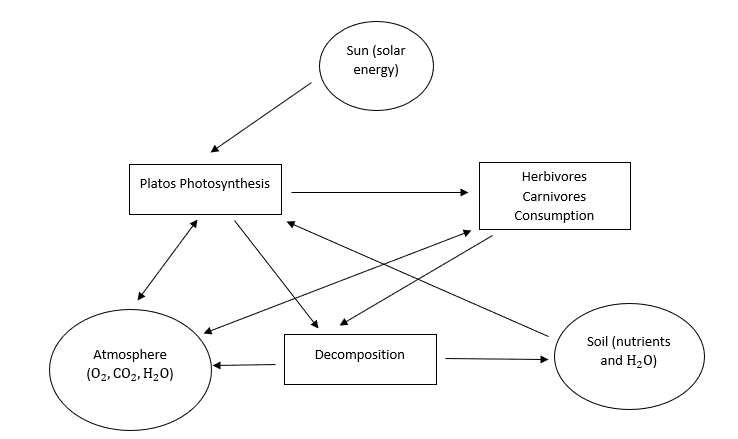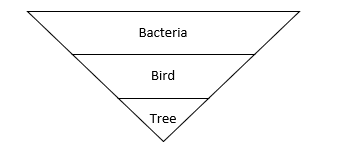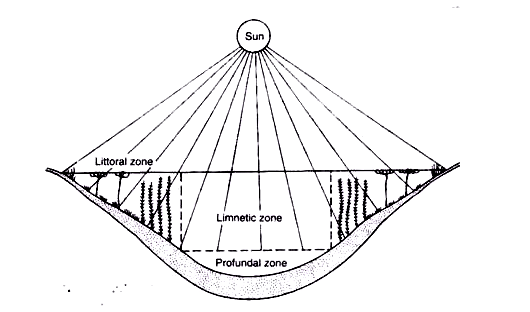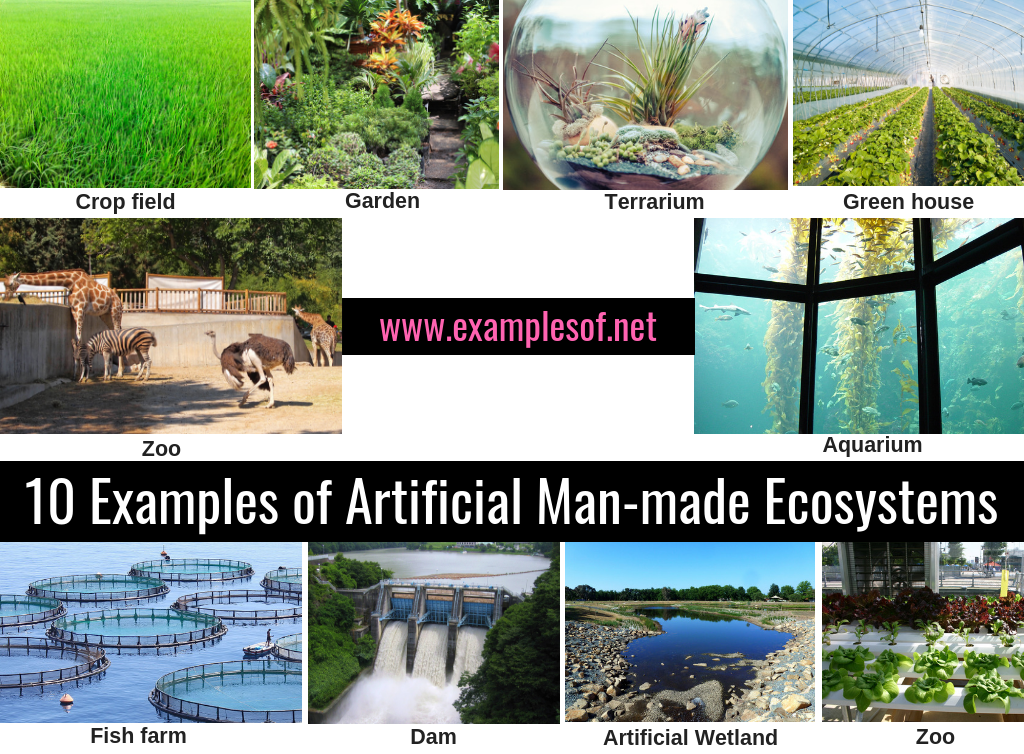What is ecosystem ecology? In short, we can say an integrated study of an ecosystem. In this article, we’ll know the components, classification, characteristics of ecosystems.
Ecosystem ecology

Definition: Ecosystem ecology is the combined study of components of ecosystems and their interactions. Briefly, we can say ecosystem ecology is the study of the interactions between biotic (living) and abiotic (non-living) components within an ecosystem framework. We have to study the components, characteristics, classification of ecosystems. So, let’s go for it.
What is an ecosystem?

Definition: An ecosystem is a dynamic system where the biotic and abiotic components constantly act and react upon each other, bringing forth structural and functional changes in a community. Thus, the term ‘Ecosystem’ was coined first by British Ecologist A.G. Tansely (1935).
“An ecosystem is a complex interacting system of a community and its abiotic environment.”
Ecosystems have specific structural components (the organisms and the physical environment) interacting among themselves (through the processes of energy flow and cycling of materials) to accomplish the goal of the continuance of life. None of the ecosystems is independent, but all of them are interdependent in one way or another.
Such eating and being eaten relationship among living organisms involves two main processes. First, only the green plants and some autotrophic bacteria can synthesize their own food by utilizing solar radiant energy (light) to bind simple molecules of O2, H2O, and other elements as N, P, Ca, K, Mg, S, etc.

The flow of energy: the energy used by the plants passes through various organisms and is ultimately lost as heat. It is called the flow of energy.
Bio-geochemical cycling: The energy and chemical substances pass through the organism but become available for use again and again. Therefore, the process is known as biogeochemical cycling.
The two processes bind the organisms (eating and being) and their environment into an interacting complex unit.
Ecosystem Synonym
- Atmosphere
- Biosphere
- Ecosphere
- Biome
- Bionetwork
- Biota
- Biotic
- Ecology
- Environment
- Environs
- Flora and fauna
- Gaia
- Habitat
- Biodiversity
- Wetland
- Plant life
- Ecological community
- Earth’s system of natural resources
General characteristics of an ecosystem:
Smith (1966) emphasized the following general features of the most ecosystem:
- The ecosystem is a primary structural and functional unit of ecology.
- The structure of an ecosystem is related to its species diversity.
- The function of an ecosystem is related to energy flow and material cycling through and within the system.
- The relative amount of energy needed to maintain an ecosystem depends on its structure. The more complex, the lesser the energy it needs to sustain itself.
- Ecosystems mature by passing from less complex to more complex states. Early stages of such succession have excess potential energy and a relatively high energy flow per unit biomass. Later (mature) stages have less energy accumulation, and they flow through more diverse components.
- The environment and the energy fixation in any given ecosystem are limited and cannot be exceeded without causing severe undesirable.
- Alteration in the environments represents selective pressures upon the population to which it must adjust. Organisms that are unable to adapt to the changing environment must vanish.
Classification of Ecosystem:

Types of the ecosystem:
Natural ecosystem:
- Terrestrial ecosystem:
- Forest ecosystem
- Grasslands
- Desert
- Weed land
- Aquatic ecosystem:
- Freshwater ecosystem, e.g., pond ecosystem
- Ocean/marine ecosystem, e.g., Indian ocean ecosystem.
Artificial ecosystem:
- Cropland ecosystem
- Fish form ecosystem
Components of the ecosystem:
According to the structural viewpoint: there are four (4) components of the ecosystem. These are-
- Abiotic substances:
- Mineral elements.
- Organic compounds.
- Water
- Physical matters, e.g., sunlight, wind, gaseous elements
- Producers: all green plants and autotrophic bacteria
- Consumers: insects, bird, cow, etc. and
- Decomposers and transformers: microorganisms
According to description (Odum):
- Autotrophic components/autotrophs: photosynthesizing organisms like green plants, photosynthesizing bacteria, chemosynthetic bacteria, etc.
- Heterotrophic components/ heterotrophs: all organisms other than photosynthetic.
In general, components of the ecosystem are:
1.Abiotic components: soil, atmosphere, radiation from the sun, water, nutrients, etc.
2.Biotic components: a. producers, b. consumers, c. decomposers, and d. transformers
Abiotic components:
The physical environment with its several interacting variables constitute the abiotic component of the ecosystem. Basically, it consists of-
- The solid mineral matter on the earth (Lithosphere),
- The water in the oceans, rivers, and icecaps, etc. (hydrosphere),
- The gaseous mixture in the air (atmosphere) and
- The radian solar energy.
The position and movement of the earth and its gravitational force are additional components of the environment. These components interact with the rocks, water, and gases and with the organisms to produce the complex environment with numerous identifiable variables such as heat, light, rain, snow, mist, fog, wind, dust, storm, fire, etc.
The environment thus created and maintained by the interaction of these variables functions as a whole unit. Any of the factors cannot be removed or altered without affecting the other factors. Therefore, the environment is called ‘holocoenotic’ or ‘holistic’ (Friedrichs 1930).
Biotic components:
Biotic components are two types i.e., producers/autotrophs, and consumers
1. Producers/autotrophs:
they can produce their own food. Producers or autotrophs are organisms that manufacture the organic compounds they use as a source of energy and nutrients. Most producers are green plants (with chlorophyll) that can manufacture their food through the process of photosynthesis. Other producers are certain bacteria (chemosynthetic and photosynthetic). Since these organisms produce food for all the other organisms, they are also known as producers.
2. Consumers:
The organisms, which ingest food digest it inside their bodies are called consumers or phototrophs. All the animals are consumers. The animals may be: Herbivores, Carnivores, or Omnivores.
Types of consumers:
- Primary consumers/Herbivores (plant-eating): they depend only on the producers, i.e., green plants—E.g., insects, cattle, goats, deers, butterflies, etc.
- Secondary consumers/Carnivores (animal eating): Carnivores depend for food on the primary consumers (Herbivores). E.g., frogs, snakes, etc.
- Omnivores: they eat all kinds of food—E.g., cockroaches, human beings, etc.
- Top-level consumers: they are not eaten by the other animals/consumers—E.g., lion, tiger, crocodile, etc.
- Decomposers: decomposers are mostly saprophytic bacteria and fungi. They act on the dead matter to form simple molecules.
- Transformers: Transformers are mainly saprophytic bacteria. They act on dead organic matters to form simple organic and inorganic matters.
- Heterophytes are divided into bio pages and saprophages.
- Biophages: feeding on living organisms. E.g., all consumers.
- Saprophages: feeding on dead organic matter. E.g., decomposers and transformers.
The following graphical model describes the major ecosystem components and their interrelationship.

Food chain:
The transfer of food from the producers through a series of organisms with respected eating and being eaten forms a chain is called the food chain. The transfer of food energy from the producers through a series of organisms with repeated eating and being eaten in the form of a chain is known as the food chain.
For example, marsh grass is consumed by grasshopper. Then, the grasshopper is consumed by a bird, and that bird is consumed by the hawk. Thus, a food chain is formed, which can be written as follows:

Types of food chain:
There are three types of food chains in nature:

Food Web:

There are many food chains in an ecosystem. These food chains are not independent but are interlinked, forming some sort of interlocking pattern or developing a network of energy flow, referred to as a food web. In short, several food chains interlock with each other to form a complex network termed a food web. It describes the complex pattern of energy flow in an ecosystem by modeling ‘who consumes whom.’ For example, in a forest ecosystem, plants may be eaten by the rabbit in the absence of squirrels.
The rabbit, in turn, may be directly consumed by the wolf or by the fox first, which is then eaten by a wolf. Thus, alternatives are found there that all together constitute some sort of interlocking pattern – the food web.

Trophic level:
- Each level of the food chain is called a trophic level.
- The producers and consumers in an ecosystem can be arranged into several feeding groups in a sequence of eating and being eaten. Each group is known as a trophic level.
The producers are the first trophic level, the herbivores are the second trophic level, and the carnivores are the third trophic level, and so on.
ECOLOGICAL PYRAMID:
The sequential arrangements of various consumers of various trophic levels, based on the number of biomass or weight of organisms, etc., at each trophic level may be graphically shown in a pyramid structure which is known as the ecological pyramid. Or, when the number of energy flow or the biomass of different trophic levels of a food chain is shown graphically one above the other, it gives a pyramidal structure called an ecological pyramid.
Types of the ecological pyramid:
Based on the trophic levels, ecological pyramid are of three types:
1. Ecological pyramid of number:
The pyramid of number deals with the relationship between the number of primary producers and consumers of different orders. This is of two types:
A. Upright: The base of the pyramid is represented by producers, which are the most abundant. In the successive levels of consumers, the number of organisms decreases rapidly until there are a few carnivores.
This type of pyramid is represented here by taking an example of a grassland ecosystem. Here, the number of grass plants is very high. The number of insects like grasshopper is less than the number of grass plants. The number of frogs is less than the number of grasshoppers. The fourth trophic level’s carnivores are still smaller, and the top level is occupied by a few top carnivores. Thus, in the ecological pyramid of numbers, there is a relative reduction in the number of organisms and an increase in the size of the body from base to apex in an upright pyramid.

B. Inverted

2. Ecological pyramid of biomass:
A. Upright – Terrestrial

B. Downright – Aquatic

3. Ecological pyramid of energy: always upright
Productivity:
The amount of production (dry matter) per unit of area per unit of time is called productivity.
Types of productivity:
- Primary productivity
- Secondary productivity
- Net productivity
Ecological efficiency (EE):
The ratio of energy flowing between various trophic levels is expressed as ecological efficiency.
Types of ecological efficiency:
1. Progressive efficiency: the ratio of energy transfers between two successive trophic levels. E.g.

2. Ecological growth efficiency: a ratio between the net production and the energy assimilated at a particular trophic level.
3. Assimilation efficiency: assimilation efficiency =

Components of Agro-ecosystem:

From the structural point of view, a Riceland agro-ecosystem consists of the following components:
Abiotic components:
This includes-
- Mineral elements like
- Water/moisture of the area.
- The soil of the area.
- Solar radiation received from the area.
Function:
Biotic components provide the raw materials for the synthesis and perpetuation of the organic component.
Biotic components:
This includes all the living organisms and is sub-divided into the following components:
1. Producer: All autotrophic organisms can convert solar energy into chemical energy by photosynthesis. In the Riceland ecosystem, rice plants and associated weeds are producers. Producer observed in Riceland are:
- Oryza sativa
- Cynondondactylon
- Euphorbia hirta
- Cyperus
- Penicumete
Function: converts solar energy into chemical energy of organic food through photosynthesis.
2. Consumer: All animals (including insects) ingest carbonic food and cannot convert solar energy into chemical energy. In the case of Riceland ecosystem:
Primary consumers are:
- Grasshopper
- Ant
- Rice hispa
- Birds, etc.
Secondary consumers:
- Frog
- Snake
- Preying bird (Fingha)
Function: consumers allow to flow of energy and cycling of materials which ensures the system’s stability and continuity of lives.
3. Decomposers and transformers: Decomposers are mostly saprophytic bacteria and fungi. They act on dead matters to form a simple molecule. Transformers are mainly saprophytic bacteria. In the Riceland ecosystem, decomposers and transformers are:
- Decomposers: Bacillus, Clostridium, Pseudomonas, Rhizobium
- Transformers: Agaricus, Fusarium, Aspergillus, Helmitsthesporium etc.
Function: decomposers act on dead organic matters to form simple organic and inorganic matters. But transformers mainly act on simple organic and inorganic matters and convert them up to molecular levels.
POND ECOSYSTEM:
The ecosystem of a pond is an example of a self-made freshwater ecosystem. In this ecosystem, the close relationship of living and non-living organisms in a pond is understood clearly.

Based on water depth, vegetation, and animals, there may be three zones in a lake or pond littoral, limnetic and pro-fundal. The littoral zone is the shallow water region which is usually occupied by rooted plants. The limnetic zone ranges from the shallow to the depth of effective light penetration, and associated organisms are small crustaceans, rotifers, insects, and their larvae and algae. Finally, the pro-fundal zone is the deep-water part where there is no effective light penetration. The associated organisms are snails, mussels, crabs, and worms.
The main components which constitutes the ecosystem of a pond are described below:

A. Abiotic components: abiotic components of a pond are non-living and play a vital role in the ecosystem. These are divided as follows:
- Inorganic components: these are pond soil, mineral salts; besides, gaseous-like elements are also note-worthy. These elements are used by the green plants of a pond like phytoplankton, algae for food production.
- Organic components: the dead remains of plants and animals of the pond are the primary source of organic components. Decomposers like fungi and bacteria act upon the dead remains of plants and animals and turn them into organic compounds. A portion of the organic components is transformed into organic salts, taken by the green plants as nutrients.
B. Biotic components: all living organisms of a pond are biotic components of this ecosystem. These are divided into two basic types: Autotrophs and Heterotrophs.
Autotrophs: the living organisms, which can produce their own food with the help of solar energy in photosynthesis, are known as autotrophs. They are the producers. The primary producers in a pond ecosystem are large and other aquatic plants, such as Azolla, Hydrilla, Wolffia, Lemna, Nymphaea, etc.
Phytoplankton, green algae, etc., are also producers. They are either floating or suspended or rooted at the bottom. These green plants convert radiant energy into chemical energy through photosynthesis. The chemical energy stored in the form of food is utilized by all organisms. Oxygen evolved by producers in photosynthesis is used by all living organisms in respiration.
Heterotrophs: the living organisms, which cannot produce food of their own by photosynthetic process, are known as heterotrophs. They are also known as consumers. They are dependent directly or indirectly on the producers of food. They may be divided into the following groups: Macro consumers and Micro consumers.
Macro consumers: they are divided as follows:
- Primary consumers: the consumers like floating micro insects, the larva of order odonatan, Coleoptera, Ephemeroptera, zooplankton, tadpole larvae of frog, etc. eat the phytoplankton and undergo growth and development.
- Secondary consumers: they depend on food on the primary consumers. They are the small fishes, some aquatic insects, snail, frogs, snakes, etc.
- Tertiary consumers: the tertiary consumers are those, which take secondary consumers as food. E.g., big fishes like the barbell, catfish, walking fish, trout, turtle, etc.
Micro consumers: these are as follows:
- Decomposers: the pond living organisms that decompose the dead remaining producers and consumers and degrade the complex organic substances into simpler compounds are known as decomposers. E.g. fungi, bacteria etc.
- Transformers: the decomposed organic materials again are transformed into inorganic forms through the activity of another kind of bacteria called transformers. The decomposers and transformers play a significant role in maintaining the dynamic nature of the ecosystem.
OCEAN ECOSYSTEM:
The oceans constitute nearly 70% of the earth’s surface. The sea has exceptional stability in temperature, salinity, and gaseous content. The upper portion of the oceanic region through which lite penetrates is called the euphotic zone. The region of the ocean below the euphotic zone (below 200 meters) is called benthal. It is also known as the aphotic zone. This zone is completely free of photosynthetic organisms.
A different set of environment and conditions is present in each ocean zone, and each zone has its own peculiar life form. Planktonic organisms are algae, diatoms, protozoans, small crustaceans, and their eggs. The seashore organisms live under variable physical conditions, and they are constantly under the impact of waves. Most of them are covered and exposed twice daily by the rise and fall of the tides.
STREAMS AND RIVERS:
In the rivers and streams in shallow water, the velocity of water or current is excellent to keep the bottom clear. Filamentous algae are a typical example. However, in deep water, the water current velocity is reduced, and silt and other loose materials tend to settle at the bottom.
WETLANDS:
Wetlands are marshes and swamps, which are low-lying wetlands, and their ecosystem is suitable for ducks and other semi-aquatic animals. Swamps also support large trees and shrubs. They have various types of environmental conditions, both aquatic and semi-aquatic. Aquatic insects, reptiles, and birds are common in such regions.
FOREST ECOSYSTEM:
About 40% area of the world is covered by forest. Based on the climatic condition, different types of forests are found. A forest ecosystem is the best example of a terrestrial ecosystem. The main components which constitute the ecosystem of a forest are described below:
1. Abiotic components: abiotic components of a forest are those, which are non-living and play a vital role in the ecosystem. These are divided as follows:
- Inorganic components: these are forest soil, mineral salts, gaseous element like, etc. are noteworthy too.
- Organic components: the dead remains of plants and animals of the forest are the primary source of organic components. Decomposers like fungi and bacteria act upon the dead remains of plants and animals and turn them into organic compounds. A portion of the organic components is transformed into inorganic salts, taken by the green plants as nutrients.
2. Biotic components: all living organisms of a forest are biotic components of the ecosystem. These are divided into two basic types:
A. Autotrophs: the living organisms, which can produce their own food with the help of solar energy in photosynthesis, are known as autotrophs. They are the producers. These are the green plants of the forest. There are several layers of vegetation in the forest. The plants of the top stratum are angiospermous and gymnosperms trees. These plants utilize the radiant energy of the sun to the greatest extent. Below the level of trees, there is a layer of shrubs that consume light energy of low intensity coming through trees. Just below the shrubs, there are grasses, herbs, mosses, and ferns. They also manufacture food. These plants get the last light.
B. Heterotrophs: the living organisms, which cannot produce food of their own by photosynthetic process, are known as heterotrophs. They are also known as consumers. There are several consumers in old and dense forests. They are dependent directly or indirectly on the producers of food. They may be divided into the following groups:
Macro consumers: these are as follows:
- Primary consumers: primary consumers of the forest are grasshopper, rabbit, deer, monkey, bird, and many other wild herbivores, which take their food directly from plants.
- Secondary consumers: the secondary consumers are wolves, jackals, etc., which consume the flesh of herbivores.
- Tertiary consumers/top-level consumers: the tertiary consumers are those, which take secondary consumers as food. Like lions, tigers, hawks, etc., are the consumers of top-level.
Micro consumers: these are as follows:
- Decomposers: the pond living organisms that decompose producers’ and consumers’ dead remains and degrade the complex organic substances into simpler compounds are known as decomposers. E.g. fungi, bacteria etc.
- Transformers: the decomposed organic materials again are transformed into inorganic and elemental forms through the activity of another kind of bacteria called transformers. The decomposers and transformers play a very important in maintaining the dynamic nature of the ecosystem. These free elements are re-utilized by producers in their nutrition.
ARTIFICIAL ECOSYSTEM:

Gardens, parks, vegetable gardens, and agricultural lands are artificial or man-made ecosystems. A balanced aquarium is also an artificial ecosystem. The space capsule, which lasts for a limited period, is also an artificial ecosystem. For longer journey on spacecraft includes all the essential components of the ecosystem, namely producers, consumers, decomposers, and abiotic components.
ECOLOGICAL NICHES:
Species of plants and animals present in an ecosystem perform different functions. The role of each species is spoken of as its niche. In other words, the total role of a species in the community is the ecological niche. The ecological niche includes the species of organisms, environmental factors, the area in which the species live, and the specialization of species population within a common structure and adaptation of that population. The ecological niche is not a simple concept, but it relates to the ideas of population and community.
The niche is the community’s property, which represents the place of the population in the community structure. Different communities in an ecosystem characterized by similar environments are often similar in their structure, and they may contain one or more niches that are essentially identical. The adaptations of the population inhabiting these niches may also be similar, even though they are entirely unrelated.





